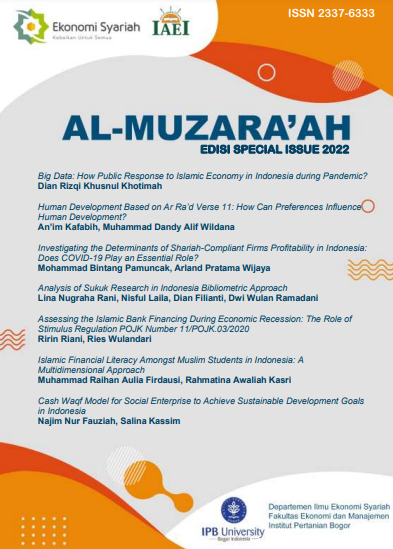Investigating the Determinants of Shariah-Compliant Firms Profitability in Indonesia: Does COVID-19 Play an Essential Role?
Main Article Content
Abstract
This study aims to seek the determinants of sharia-compliant firm profitability in Indonesian JII listed companies. This study employed Data Panel regression analysis using the 12 most consistent companies who listed in the JII during the period of Q1 2015 to Q4 2020 where in total, there are 282 number of observation. The study found that both firm-internal and firm-external variabels are significant in determining firm profitability on at least one model of data panel regression. COVID-19 and GDP used to measure the impact of firm-external variables, while working capital, debt to equity ratio, and quick ratio used to determine firm-internal variable. Further studies are required to observe the longer period of COVID-19 impact on sharia-compliant firm profitability.
Downloads
Article Details

This work is licensed under a Creative Commons Attribution-ShareAlike 4.0 International License.
Author(s) who published in this journal agree to following terms:
- Authors understand and agree that copyright of manuscripts published are held by Al-Muzara'ah. The statement to release the copyright to Al-Muzara'ah is stated in form CTA (link doc).
- Copyright encompass exclusive rights to reproduce, to distribute, and to sell any part of the journal articles in all form and media.
This work is licensed under a Creative Commons Attribution-ShareAlike 4.0 International License (CC BY-SA) where Authors and Readers can copy and redistribute the material in any medium or format, as well as remix, transform, and build upon the material for any purpose, but they must give appropriate credit (cite to the article or content), provide a link to the license, and indicate if changes were made. If you remix, transform, or build upon the material, you must distribute your contributions under the same license as the original.
References
Alharbi, A. T. (2017). Determinants of Islamic banks' profitability: International evidence. International Journal of Islamic and Middle Eastern, 10(3).
Ali, M., & Puah, C. H. (2019). The internal determinants of bank profitability and stability: An insight from banking sector of Pakistan. Management Research Review, 42(1).
Alipour, M. (2011). Working capital management and corporate profitability: Evidence from Iran. World applied sciences journal, 12(7), 1093-1099.
Alsharari, N. M., & Alhmoud, T. R. (2019). The determinants of profitability in Sharia-compliant corporations: evidence from Jordan. Journal of Islamic Accounting and Business Research, 10(4).
Alshater, M. M., Hassan, M. K., Khan, A., & Saba, I. (2020). Influential and intellectual structure of Islamic finance: a bibliometric review. International Journal of Islamic and Middle Eastern Finance and Management.
Asimakopoulos, I., Samitas, A. & Papadogonas, T. (2009). Firm specific and economy wide determinants of firm profitability: Greek evidence using panel data. Managerial Finance, 35(11), 930-939.
Bhayani, S. J. (2010). Determinants of profitability in Indian cement industry: An economic analysis. South Asian Journal of Management, 17(4), 6-20.
Boadi, E. K., Antwi, S. & Lartey, V. C. (2013). Determinants of profitability of insurance firms in Ghana. International Journal of Business and Social Research, 3(3), 43-50.
Burja, C. (2011). Factors influencing the company’s profitability. Annales Universitatis Apulensis Series Oeconomica, 13(2), 215-224.
Chowdhury, A. & Amin, M. (2007). Working capital management practiced in Pharmaceutical companies in Dhaka stock exchange. BRAC University Journal, 4(2), 75-86.
Cyril, E. J., & Singla, H. K. (2020). Comparative analysis of profitability of real estate, industrial construction and infrastructure firms: evidence from India. Journal of Financial Management of Property and Construction, 25(2).
Dalci, I. (2018). Impact of financial leverage on profitability of listed manufacturing firms in China. Pacific Accounting Review, 30(4), 410–432.
Dong, H. P., & Su, J. T. (2010). The relationship between working capital management and profitability: a Vietnam case. International Research Journal of Finance and Economics, 49(1), 59-67.
Eljelly, A. M. (2004). Liquidity‐profitability tradeoff: An empirical investigation in an emerging market. International journal of commerce and management, 14(2), 48-61.
Gill, A., Biger, N., & Mathur, N. (2010). The relationship between working capital management and profitability: Evidence from the United States. Business and Economics Journal, 10(1), 1-9.
Hanafi, S. M. (2011). Perbandingan kriteria syariah pada indeks saham syariah Indonesia, Malaysia, dan Dow Jones. Asy-Syir’ah Jurnal Ilmu Syariah dan Hukum, 45(11).
Hassan, M. K., Aliyu, S., Saiti, B., & Halim, Z. A. (2020). A review of Islamic stock market, growth and real-estate finance literature. International Journal of Emerging Markets.
Kasmir. (2013). Analisis Laporan Keuangan Cetakan Keenam. Jakarta (ID), PT. Raja Grafindo Persada.
Lazaridis, I. & Tryfonidis, D. (2006). Relationship between working capital management and profitability of listed companies in the Athens stock exchange. Journal of Financial Management and analysis, 19(1), 26-35.
Malik, H. (2011). Determinants of insurance companies profitability: an analysis of insurance sector of Pakistan. Academic Research International, 1(3), 315-321.
Modigliani, F. & Miller, M, H. (1958). The cost of capital, corporation finance, and the theory of Investment. The American Economic Review, 48(3), 261-297.
Nanda, S., & Panda, A. K. (2018). The determinants of corporate profitability: An investigation of Indian manufacturing firms. International Journal of Emerging Markets, 13(1).
Orhun, E. (2021). The impact of COVID-19 global health crisis on stock markets and understanding the cross-country effects. Pacific Accounting Review, 33(1).
Pindyck, R.S. and Rubinfield, D.L. (1998). Econometric Models and Economic Forecast, Fourth Edition. New York (US), McGraw Hill.
Salike, N. & Ao, B. (2018). Determinants of bank’s profitability: role of poor asset quality in Asia. China Finance Review International, 8(2).
Supriatna, A. & Wardana, A. (2020). Pengaruh net working capital dan debt to equity ratio terhadap return on equity pada pt astra international tbk. Jurnal Disrupsi Bisnis, 3(2), 205-222.
Tyagi, S. & Nauriyal, D.K. (2017). Firm level profitability determinants in Indian drugs and pharmaceutical industry. International Journal of Pharmaceutical and Healthcare Marketing, 11(3).
Wooldridge, J.M. (2001). Econometric Analysis of Cross Section and Panel Data, Second Edition. London (UK), MIT Press.
Yazdanfar, D. (2013). Profitability determinants among micro firms: evidence from Swedish data. International Journal of Managerial Finance, 9(2).

